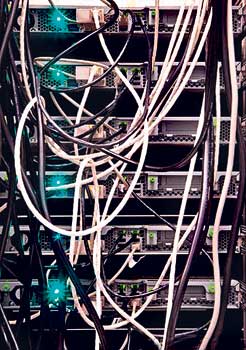
Binding force
One of the common clichés of our time is that technology is 'moving' forward at a binding speed dragging us along with it. Innovations in technology over the years have been achieved by combining different tools in creative new ways as much – if not more than – by inventing new ones. Flint and stone tools were invented by prehistoric man for hunting and food processing, but they also enabled him to make fire. The invention of the wheel was significant enough in its own right, but the productivity of the wheel increased exponentially when it was first combined with domesticated animals and later with 'fire' in the 'automobile.' Similarly, as significant a technological innovation as the computer is in its own right, it has been combined with other tools to improve the overall productivity and use. Ingenious use of computers today has made our cars more efficient, but they have also been applied to automate simple and repetitive tasks such as making the double entries in automated accounting systems. The result has consistently been improvements in efficiency and productivity. Computers take many forms and sizes today, varying in size, ability and power, from bulky server farms to GPS enabled wrist watches. I have no research data to back up this assumption, but it seems safe to assume that mobile phones are perhaps the most commonly found computing devices in Sri Lanka and even the world over. Even though they are all primarily intended to be communication devices, numerous other functions are being bundled into mobile phones such as digital cameras, music players, personal organisers, email, internet browsers and GPS, apart from the more common calculating and address-book functions. Most of the latest mobile phones can be synchronised with personal computers and users can add new third party applications to them. Given the spectrum of opportunity that these latest mobile phones offer, I am surprised that they have not been used in more creative ways. The comprehensive identity verification and security check that is carried out with the issue of each mobile phone connection in Sri Lanka provides the foundation for them to be used for a wide range of functions.
Since the identity of the owner of the mobile phone can be more easily verified remotely (given that newer phones can make video calls, enabling photo recognition), they have a lot of potential to be used as business and trade tools, even to make payments with minimal risk. Using your video enabled phone to make a payment, for example, could be safer than making a payment by giving out your credit card details as the latter has no photo verification capability. Such use and applications of technology has the potential to foster more trade in countries such as ours where the use of credit cards is less common in the lower income bracket of the population who still use mobile phones. Mobile communication technology has many more applications that can be helpful in myriad situations from monitoring conflict situations to reporting and receiving news as done by Jasmine Newswire services (http://www.jasminenews.com) in Sri Lanka. Write into technopage@gmail.com if you can think of more creative new ways that mobile communication technology can be used in Sri Lanka. Dine-more for dynamo Brace yourself for the latest in battery-charging technology for gadgets. Researchers from Simon Fraser University in British Columbia have developed a device worn much like a knee brace that generates electricity from the natural motion of walking. Wearing a device on each leg, an individual can generate up to 5 watts of electricity with little additional physical effort, according to the release. Walking quickly, however, generates as much as 13 watts. At that rate, when the energy is stored in a battery, one minute of walking time could provide enough electricity to sustain 30 minutes of talk-time on a mobile phone. Improve your computer literacy Windows Card Space Windows Card pace is a Microsoft .NET Framework version 3.0 software client that is designed to let users provide their digital identity to online services in a simple, secure and trusted way. It's an identity selector that pops up when a user needs to authenticate to a Web site or a Web service. CardSpace was previously called Infocard. It's widely expected that CardSpace will replace MSN Passport. |
|
||||||
|| Front
Page | News | Editorial | Columns | Sports | Plus | Financial
Times | International | Mirror | TV
Times | Funday
Times || |
| |
Reproduction of articles permitted when used without any alterations to contents and the source. |
© Copyright
2008 | Wijeya
Newspapers Ltd.Colombo. Sri Lanka. All Rights Reserved. |

